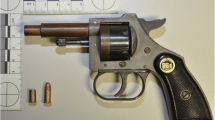Abstract
A total of 59 penetrating contact shot wounds to the head caused by handguns was investigated and a comparison was made between the magnitude and the number of fracture lines at the entrance and exit site of the vault and at the base of the skull. It was noted that in approximately 50% of the cases the extent of fractures at the entrance site exceeded those at the exit wound while in the remaining individuals no relevant differences or even greater exit fractures were found. Furthermore, no close correlation between the fracture patterns of the vault and at the base of the skull occurred indicating that differences in the magnitude and the number of entrance or exit fracture lines cannot provide reliable information on direction of fire. Additionally, no further conclusions on the gun used can be drawn from differences in the entrance and exit fracture patterns. It can only be assumed that the absence of fractures in the cranial fossae points to the use of small calibre handguns (≤ 7.65 mm) while a fragmentation of the skull can as a rule be expected after shots from guns with larger calibres (> 7.65 mm).
Similar content being viewed by others
References
Coe J (1982) External beveling of entrance wounds by handguns. Am J Forensic Med Pathol 3:215–219
Dixon DS (1982) Keyhole lesions in gunshot wound of the skull and direction of fire. J Forensic Sci 27:555–566
Dixon DS (1984) Pattern of intersecting fractures and direction of fire. J Forensic Sci 29:651–654
Fatteh A (1976) Medicolegal investigation of gunshot wounds. Lippincott, Philadelphia, pp 100–102
Gonzales TA, Vance M, Helpern M, Umberger CJ (1954) Legal medicine, pathology, and toxicology, 2nd edn. AppletonCentury-Croft, New York, pp 424–425
König HG, Schmidt V (1989) Beobachtungen zur Ausbreitungsgeschwindigkeit und Entstehungsursache von Berstungsfrakturen beim Schuli. Beitr Gerichtl Med 47:247–255
Puppe G (1914) Ober Priorität der Schädelbrüche. Ärztl Sachverst Z 20:307–309
Sellier K (1982) Schußwaffen und Schulwirkungen. I. In: Weinig E, Berg S (eds) Arbeitsmethoden der medizinischen und naturwissenschaftlichen Kriminalistik, Vol. 8, 2nd edn. Schmidt-Römhild, Lübeck, pp 198–205
Smith OC, Berryman HE, Lahren CH (1987) Cranial fracture patterns and estimate of direction of fire from low velocity gunshot wounds. J Forensic Sci 32:1416–1421
Unterhamschaidt F (1993) Pathologic des Nervensystems VI.A. In: Doerr W, Seifert G, Uehlinger E (eds) Spezielle pathologische Anatomie. Vol. 13. Springer, Berlin Heidelberg New York, pp 512–514
Author information
Authors and Affiliations
Rights and permissions
About this article
Cite this article
Betz, P., Stiefel, D. & Eisenmenger, W. Cranial fractures and direction of fire in low velocity gunshots. Int J Leg Med 109, 58–61 (1996). https://doi.org/10.1007/BF01355517
Received:
Revised:
Issue Date:
DOI: https://doi.org/10.1007/BF01355517




